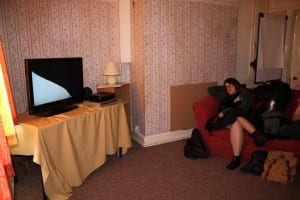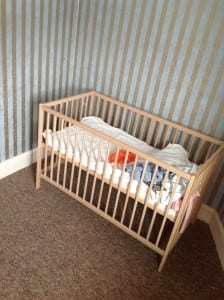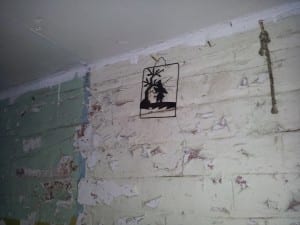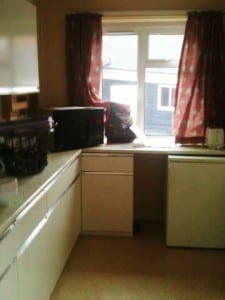My first impressions of the house on West Parade from outside was that it looked like any other house on the street. Upon entering the living room I noted the shabby wallpaper, odd coloured sofa’s and admittedly what seemed like an out of place modern TV. I say ‘out of place’, because everything in the room surrounding it looked so old and worn.
|
The Living Room in the house on West Parade. Photograph by Jozey Wade. |
The kitchen was indescribably homely, maybe because the set up was that of an ordinary kitchen, in an ordinary house. The architecture of the shed/outhouse possesses a possibility of making an interesting performance space. It is ideally located close to the kitchen and garden and contains a window viewable from the back door. I believe that transforming this space into something else could be intriguing. The aim being to highlight the contrast between the dust -filled shed against the comfort and security of home.
The large garden allows enough space for the audience to look into the house to watch the performance (looking into the action) or vice versa. The idea of the audience peering into the house creates a thrilling voyeuristic experience, it’s almost perversive.
Moving upstairs, I immediately headed for the CCTV room, it was so interesting to look at each room on the screen and watch everyone moving around the house. The CCTV room is by far an excellent performance quality that can be utilised. In the performance, I thought it might be an interesting idea to not tell the audience that there are CCTV cameras recording. Then at the end of the performance, revealing that they have been watched the whole time making them feel extremely uncomfortable. Also, I think broadcasting or streaming the CCTV to laptops, TV’s, phones to audiences in their home would also make an interesting performance quality. That notion of being watched or watching someone else would add to the performance.
The landing of the house is appealing because every room can be seen, this has the potential as an area for the audience to sit or stand and see performances occurring in each of the rooms. The last room held nothing more than a cot, surrounded by mouldy walls with peeling wallpaper. Upon entering you were engulfed by an unsettling eeriness. The cot in the room felt symbolic of childhood innocence and vulnerability.
|
The cot room in the house on West Parade. Photograph by Sam Davis. |
My first impressions of the house were ones of curiosity and excitement. Now that I have seen the house, I have so many ideas for the performance and can’t wait to try them out. From discussions when we first saw the house, I found it interesting too note that we as a group are forming the fabric of the house and becoming part of the archive just by being in the space and performing in it:
“A place owes its character to the experiences it affords to those who spend time there”. ((Pearson, Mike (2010) Site Specific Performance, Basingstoke: Palgrave Macmillan, p.16))
I think this is true of the house on West Parade because we become as contingent as the space is. The house creates it’s own parameters of performance due to its history and characteristics. I think this is why it is important to find out as much historical context as possible about the site to properly understand the environment we are in.




